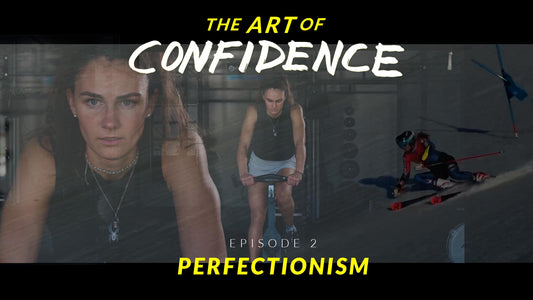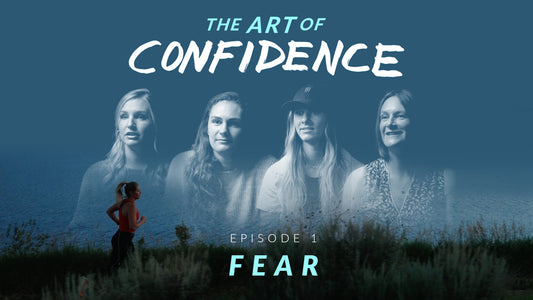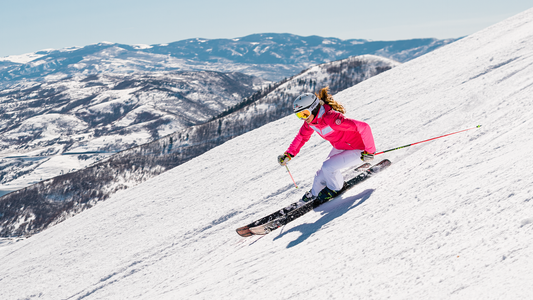Alice Merryweather navigates skiing, college, and new hobbies in unprecedented times.
World Class Downhiller, Dartmouth Undergraduate, Baking Enthusiast, 23 Year-Old Navigating an Uncertain World in 2020. Alice Merryweather is all of these things. As a promising young skier on the United States Ski Team, Alice has rolled with the dramatic changes COVID-19 has forced the world to undergo while balancing training for the 2020-21 FIS World Cup season, pursuit of an Ivy League education, and, like all of us, exploring new hobbies as life as we knew it ground to a halt this past spring. While anxiety about an uncertain future would have given anyone perfectly good reason to take a break from pursuing a World Cup podium, however, Alice took some time to tell us about how she's found creative ways to train for the upcoming season, build a chair for an engineering class, and bake some banana bread, too.
Spyder: Talk about your spring, how plans changed, grown, etc.
Alice Merryweather: I had come back to the US for US Nationals, and my plan was to get back up to Dartmouth for Spring classes, but that all got pushed remote. So, I packed up my car and drove out to Utah. I ended up just finishing up spring classes online, got into ski touring, and I’ve been in Utah or at ski camps since mid-March.
S: We saw that you had deferred Dartmouth and delayed your first year of school. Tell us a little bit about that.
AM: My college plans have been all over the place. When I was a senior in high school, I had initially applied and been accepted to Harvard, and once I made the US Ski Team the spring of my senior year, I chose to defer from Harvard for a year to be on the US Development Team. When I made the team again (the following year), I tried to defer my enrollment another year, and they said no. Skiing remained my priority, so I decided to apply to Dartmouth that fall.
I got accepted in the winter of 2017, and started school there the following spring, since it works out that it starts right at the end of March. So I go straight from US Nationals to school, and do their ten week spring quarter. I’ve done three spring terms, and am currently doing a summer term and plan to enroll in the fall term since it’s all online; hoping to shave a twelve-year plan down, hahaha.
S: What are you studying?
AM: I haven’t declared my major yet but I’m leaning towards government or geography.
S: Has Dartmouth’s move to online learning helped, or do you think it will help with being able to continue your studies in the future?
AM: Yeah, I think I’m one of the few people who is actually pretty psyched about being able to do classes remote, because Dartmouth doesn’t have any kind of online infrastructure normally. It’s been a silver lining to the whole [Covid-19] situation that I’m able to train really productively and focus on both skiing and school, instead of being at campus here my training is pretty restricted.
S: So, you packed all your stuff up, moved back out to Utah. Walk us through the next few months and your newfound interest in ski touring. What did the period when the mountains closed look like for you? Did you see it as an opportunity to re-calibrate and relax?
AM: No, I think it was a pretty high-stress spring. Initially when I was driving out [to Utah], my housing fell through while I was literally in Iowa. The place I planned to stay for the next two months didn’t work out. Since then, though, I’ve been staying in a condo in Deer Valley, which has been wonderful, but I think that for a lot of the spring I was a bit stuck in my own head, wondering if I’d made the right decision to be away from my family. I was less concerned about skiing, since the season had been cancelled anyway. I was more stressed about school, and just didn’t feel super settled down here for a while; wondering if I’d be able to go to the grocery store, where I’d be able to do workouts, where was I going to take classes and when were we going to be on snow. It took a little while to realize that all of those things were out of my control, and so it’s been a real mental exercise. It probably took until mid-May to settle down and take a breather.
S: Wow. So were you just doing workouts from home, since the US Ski Team’s Center of Excellence was shut down?
AM: I actually lucked out and was able to get one of their last sets of weights to take home, so I had everything I needed to do basic strength training.
S: What other hobbies do you have? Did you pick up any new ones during your time away from the usual alpine training that helped you stay sane during this unprecedented period?
AM: Yeah! I had never ski toured before, so getting out to do that was really fun. I’m also definitely guilty of getting on the baking craze; baking banana bread and muffins and stuff, which I fully embraced. A lot of cooking in general, learning new recipes and getting a little bit inventive. With school, I had a higher-than-normal course load, so I was able to grind a lot on classwork without having to balance training, which was nice.
S: As far as school goes, do you have any mentors or strategies to help balance school and life on the US Ski Team?
AM: I’m certainly far from the first person to follow the Dartmouth/US Ski Team plan; following in the footsteps of some very accomplished people, and they’ve all helped me a lot. Even some of my teammates my own age like Nina O’Brien have helped me. I think coming out of a ski academy helped me to manage the skiing/schoolwork balance, so I’ve been able to manage my time pretty well and I’ve always been pretty organized given the amount I was traveling for skiing in high school.
S: Have there been any times recently that you had to take a test on the road? What does that look like?
AM: Most of the classes I’ve been in recently have been mostly project-based. Actually, while we were training in Mt. Hood, I had to design a cardboard chair for an engineering class. Of course, it overlapped with the week I was at ski camp and didn’t really have any cardboard with me. I did all the preliminary sketches, planned it all out, but ended up making the tiniest cardboard chair ever given the materials I had. Nina [O’Brien] was actually in the same class, so after skiing we’d go and cut out cardboard, make sketches, and managed to produce some very miniature cardboard chairs.
S: So sitting in it wasn’t a requirement, we assume?
AM: Fortunately not! If we’d been on-campus, in a normal term, we’d have had to sit in it. We ended up photoshopping ourselves into the mini chairs instead. Thankfully, they didn’t have to be human weight-bearing.
S: So, back to skiing following the lock-down period, did you go to the US Alpine Team’s training at Copper Mountain as well? If so, what was it like getting back on snow after not skiing for a while?
AM: Yes. It was definitely odd, but everyone on the team really stepped up in terms of wearing their masks, and Copper did a great job of properly enforcing the social distancing guidelines. The training looked very different, given that we couldn’t ride the lift up with our friends or interact with any of the other teams that were training there. But we all felt so lucky to be on snow. Honestly, after doing some touring during the spring, I didn’t feel too out of balance or out of my element. There was just so much joy to be back on race skis and training in that environment, no matter how different it looked. I think the only thing I could do was embrace the moment wholeheartedly.

S: Leading up to that, have you been working with the US Ski Team to establish goals for the season, or even just the summer? What have those looked like?
AM: I’ve been in constant contact with my coaches about goal-setting, and every change that they hear about from FIS regarding what the season may look like. I’m not changing my goals, because even if the season looks different, I’m still aiming to be skiing as fast as I can and working my butt off to get onto the podium. Trusting that some sort of season will be happening this winter has helped me stay accountable in terms of my training. April rolled around, and we were already getting conditioning schedules from our coaches. It was stressful that we were starting to do workouts without knowing whether we’d be on snow, especially given that I didn’t want to burn out in the event there wasn’t a season. Accountability to the coaches and the team, knowing that whatever else happens is beyond my control, is how I stayed focused.
S: When do you typically start in the gym, and how much was added?
AM: Typically we’re back on snow by May, and try not to push it too hard before that. But given our inability to do that, it opened the door to doing lots and lots of cardio reps all spring. It was like an additional Fall block, but with school, I had to manage things and took things a little bit lighter in order to maintain a balance there. We had to keep changing things day by day as the opportunity to get on snow changed. Overall, we were able to spend about nine days on snow.
S: For on-snow training, were there teams there from all over the world?
AM: It was mostly just the US team. I hadn’t been to Mt. Hood in nearly six years, so that was a lot of fun because it reminded me of going to sleep away camp there when I was younger. But there was social distancing in the lift lines, everyone wore masks, and there were all age groups. There were even younger kids training with their club teams there. Copper definitely differed from Mt. Hood, since in June we still hoped this might be temporary, and that it might be going away soon. At Mt. Hood, everyone understood it wasn’t something to be taken lightly, and everyone there was super respectful of following the protocols.
We had amazing weather at Mt. Hood, and had the opportunity to really hammer fundamentals in events like GS, since the glacier doesn’t offer the opportunity to do a whole lot of speed skiing during the summer. But it was great to get those reps in since those fundamentals really transfer to my speed skiing. While we haven’t had any speed reps yet, I think that training will really carry over, so I have a lot of confidence going into the fall.

S: As far as ski racing is concerned, are there any particular times that you feel most in your element?
AM: Oh, man, at unexpected times almost. I think I get the most joy out of skiing GS, but don’t tell my coaches that! There’s a really beautiful feeling about rhythmic GS turns being executed well; I can just feel everything line up--feel the skis respond underneath my feet--and that’s just one of the coolest sensations to me. When I’m back skiing in New Hampshire at Attitash, it’s so comfortable, so magical to go back skiing there every year. It feels so much like home. There’s definitely also a crazy sensation about going 70-80 miles per hour on a pair of skis that is terrifying, but so exhilarating, and such an adrenaline rush. I think those three moments for me are all very different, but equally joyful when skiing.
S: With the current uncertainty of the ski season, do you have any advice for kids and/or their parents?
AM: With everything so up in the air, the most important thing is not to overthink it and don’t stress about things that are out of your control. Just keep working hard under the assumption there is a season coming up. Every skier should be prepared for that. Beyond that, the best we can do is be optimistic and keep an open mind. Don’t stress about it, because, ultimately, if we don’t have a season it will be for the right reasons.
S: What upcoming plans do you have in the next few months as you prepare for the season?
AM: I’m going to finally go home to Massachusetts to see my family, which I’m super excited about since I haven’t seen them in over five months now. Then, the US Ski Team is going over to Europe! We were able to get Visas, and we’re heading over at the beginning of September for over a month.
S: Favorite Spyder pieces?
AM: Oh, man, all of them! The heritage pieces, especially, since they’re actually wind resistant. I’ve been able to use them for camping, too, this summer, which have been very warm on cold desert evenings. I wore it around Attitash over Christmas, which was super bold, but I got a lot of compliments on it.

S: As a fast rising star, be sure to keep an eye out for Alice this season as she competes on the world stage of alpine racing.



